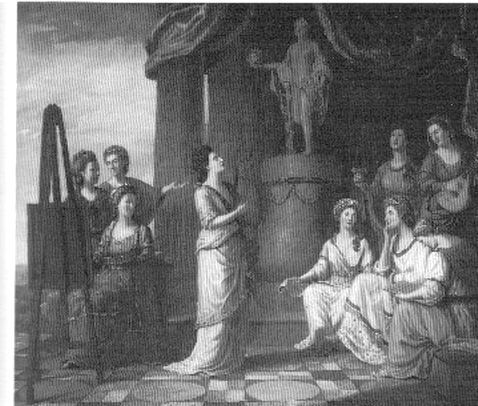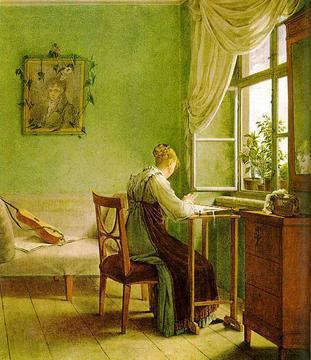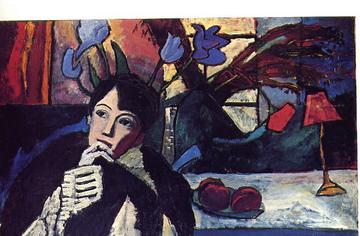
This review appeared in The Eighteenth-Century Intelligencer, N.S. 20:3 (September 2006): 42-46.
Paula Backscheider. Eighteenth-Century Women Poets and Their Poetry: Inventing Agency, Inventing Genre Baltimore: Johns Hopkins University Press, 2005. Pp. xxvii + 514; biographies (pp. 403-414); notes (pp. 411-465); bibliography (pp. 467-498); index (pp. 499-514). ISBN 0801881692. Hardcover $65

In this wise and pre-eminently useful book, Paula Backscheider maps a group of genres women poets of the long 18th century found congenial and "shaped and developed" (xviii) in a distinctively female way. She immerses the reader in women's poetry written in the genres she has chosen, and writes explicitly out of a canny knowledge of publishing practices and literary marketplaces, and how reputation and cliques function. She enables us to see how what has survived of western women's poetry across the ages is at once a vast, varied, marvelous, and misrepresented body of work. She demonstrates persuasively that the criteria by which critics today still judge most pre-20th century and more recent poetry by western women are obtuse and misleading and effectively hinder the common reader's understanding of and sympathy for most women's poems. Backscheider's book's weak points are a function of the centuries of repeated unacknowledged dismissal of women's poetry which itself derives from a mass of anti-feminist feeling against which she contends.The book's first two chapters, and the opening and closing sections of its intervening ones provide its framework. She explains which select groups of women get to write (81, 377-379) and how they still come to write certain kinds of poems in censored or slanted ways (xvii, 234-237, 268- 275). She shows how necessary but difficult to obtain for writing and reading women are friendships with other writing and reading women (232, but also passim), and the many related obstacles to publication and circulation of women's poems in respected places (387). She demonstrates that women's poems are always read as by women (their gender has "almost always been" primary in their readers' minds, 22). In the 18th and 19th century those printed and praised were presented as functioning to increase morality (8), although by and large for women poetry functions as a form of "life-writing" and "a place [for women] to be themselves" (19, 26, 106). We are led to see what a woman's career as a poet actually looks like (24, 39). She argues that for women writers we have not yet settled how to, or begun recognizing real or effective agency as opposed to imputed agency (23). She shows why what people see as a writer's "signature" work is important: she argues "The Spleen" was the poem Anne Finch was respected for and is a "statement of [her] identity as a Poet" (72-79); since we have not identified Mary Montagu's "signature" works, the variety of moods, range of types, lexical virtuosity, and allusive depths (84-101) of her poetry are not grasped and remains uninfluential in 18th century scholarship (85).
All her arguments are rooted in the particularities of the era and circumstances of her poets' lives; many are elaborated through analyses of poems. In a penultimate strong chapter (315-375), Backscheider demonstrates that women were major participants in the mid-18th century revival of the sonnet in England and interweaves perceptive sympathetic analyses of Charlotte Smith's poetic oeuvre with great and innovative lyrics by other recognizably female presences (e.g., Helen Maria Williams and Mary Robinson). She devotes deeply satisfying chapters to women's development of friendship (175-232) and retirement poems (233-67), which women used to recreate themselves in counter-universes. Such poems "had much to offer women because they often represented a person without political or public power, even an exile from decision-making" (234). Using 18th century tropes (the "happy woman"), women poets develop "a repertory of social selves" (xxiv), enjoy imaginative self-realization, and independence of spirit for a more hidden identity (233-267). The elegy when written by women is a literary genre for private contemplation, grieving, the expression of same-sex passion, entertainment, and public political intervention (269-315). Strong and fine poems by, among others, Katherine Philips, Sarah Egerton, Mary Chudleigh, Mary Jones, Mary Darwell, Elizabeth Hands, and Anna Barbauld are discussed.
Her more generally applicable commentary is also invaluable. She is determined not to claim disabilities for women which critics and readers do not believe in: for example, she writes while for some women "domestic responsibilities compete painfully with the desire to write," for others "the stability of a home" can make for a "conducive situation" (377-79). Her rhetorical goal is to persuade her readers to concede and to themselves publicize in turn crippling obstacles facing women writers: beyond centuries of legal and physical subjection, "much of women's poetry, even the poetry of the best, is lost" (386); what survives has most often been published in excerpts which omit the poem's "woman's distinct perspective" (388-390); women's poetry is chosen for publication and "placed" in books to be read in the light of "canonical male poems" (394) and masculinist norms; and the "scholarship" on women's poetry is "exceptionally uneven" (395). Here the serious "barrier to assessing women's poetry" comes from "critics who influence the way aesthetic judgements are made" (386).
The book's problem is Backscheider has too much to do. She has also chosen diplomatically to assume a generosity in her readership where there has been by her own account hardly any candor. To begin with, she cannot in one book by herself provide the centuries of winnowing that men's poetry has always undergone and provides their poetry with a consensus of what particular poems are great, important, and how to read them. For women's poetry this process began a bare half-century ago, and is still skewed by the refusal of critics writing in influential venues to contextualize women's poems against women's poetry, and the norms and values enacted in most women's lives. As with just about all anthologies of pre-mid-20th century women's literature she has often to rely on her own taste, and, partly for their historical importance, she has dwelt on poems, poets and genres readers today regard (and sometimes justifiably) as poor, bad or simply unreadable. Backscheider concedes it's crucial to make persuasive evaluative judgements (xiii, xxvi) and justifies her choices by saying she is showcasing rarely-discussed women poets and types of poetry for whom there is no modern edition. However, she then treats historically- important, widely-circulated and neglected verse as good poetry: e.g., Elizabeth Rowe's corpus, Jane Brereton's verse, religious subgenres, and Anna Seward's patriotic elegies are selected out for lengthy quotation and praise (113-174, 217-223, 293-302). The result is over 70 pages where instead of creating enthusiasm and sympathetic understanding for yet more (especially for women) wonderfully refreshing texts, her book runs the risk of demonstrating that women characteristically write inferior poetry which deserves to be treated in Germaine Greer's memorable phrase as "biodegradable" art (391).
Isobel Armstrong may be accurate when she says "a canon has not yet been founded" for women's writing (xiv), but some progress has been made. There are editions of the prose and poetry of say, Mary Robinson, Anna Barbauld, Helen Maria Williams, and (to go just outside the era to an analogous second-rank presence for the 19th century), Felicia Hemans for more reasons than because "the private passions, tenacity, and press savvy" of well-connected editors (395-396) persuaded publishers to produce them: these books have been bought by enough readers for the publishers to hope to break even. Backscheider herself recognizes unquestionably major women writers have emerged for the 18th century: she opens her second chapter with a close reading of Finch's "The Sigh" because she can be sure Finch's text stands up to readers' justifiable "demand for 'formal excellence of individual works of art'" (35) -- as do many poems of the other two major women poets of the 18th century: Mary Wortley Montagu and Charlotte Smith.
Her tactful choice of genres functions restrictively. Early on Backscheider says (reasonably enough) she cannot cover all women's chosen genres and has thus omitted women's odes, satires, comic poetry, and secular metrical or narrative tales (xxi). It may be satire and comic poetry are "vexed forms" that become "more vexed when women write it" (xxi-xxii), but it is in satire and comic narratives (and in women's prologue and epilogues) that sharp hard polemic against the underlying rooted and profound reasons for the apparently insurmontable obstacles women writers have experienced are made visible. These are also to modern readers enjoyable living poems. Backscheider's relative neglect of Aphra Behn (no verse by Behn is cited) is symptomatic of a disabling retreat. She never does suggest why women's poetry has been so consistently misrepresented, ghettoized or disregarded. At moments her book reminded this reader of the opening chapter of John Stuart Mill's The Subjection of Women (1869): like Mill, Backscheider is trying to persuade an audience with arguments which the author knows do not reach the egoistic and sexual grounds for deeply-rooted hostility and indifference, lest she re-arouse antagonism.
Two examples. After she has proved otherwise, Backscheider writes what survives of women's verse is "always to some extent accidental and fortuitous" (387). Long experience in what survives of women's writing before the mid-20th century has taught me that when a woman writes down what is angry, rebellious, subversive, or simply reveals personal harm, some local cruelty or just dissatisfaction, that portion of her text is reframed, abridged, or destroyed before publication or after the woman dies. Pepys tells us he destroyed his wife's account of her wretchedness over her isolated existence; we know he beat her because ten volumes of his intimate thoughts have been scrupulously edited and published. Second, when Backscheider claims her chosen women are not conservative, she does so by ignoring fundamental issues. Her analyses of Barbauld's poetry omit any mention of what was explicitly pointed to by Wollstonecraft when she inveighed against the "sexual character" Barbauld was determined to enact in Barbauld's poetry: Barbauld was aggressively complicit in the repression of women's sexuality and praises such self- repression wherever she sees it (116, 146-147, 283-285). Barbauld refused to support women's post-secondary education, a sine qua non for training in rigorous thought, good writing by women, and discerning women readers.
If readers and writers are to persuade a male-dominated literary establishment which still ridicules, marginalizes, and dismisses women's writers, vital poetry must be distinguished from the historically interesting, and the finerst must dominate discussions of earlier women's poetry especially. There is plenty of it. Roger Lonsdale's own male preference for realism and self-deprecating homey led to his choices for his Eighteenth-Century Women Poets, but the choice has been vindicated or at least stands as the one many readers today prefer since his book has become the centrally-used anthology for women's poetry of the period while Joyce Fullard's British Women Poets 1660-1800 has gone out of print. Lonsdale provided a wealth of information, but Fullard's anthology also suffered comparatively from the narrow subjective basis of taste she also had to rely on (her own), although she did include the fiercely emotional (gush) and laconic, sensual fantastic, vatic, and faery poetry, and the radical polemics found in Backscheider's omitted genres (such as in odes the identification of women writers with small powerless animals). We can see the gradual increase in knowledge and appreciation of women's good poetry in anthologies organized by eras and based on how women's poetry evolved: all these traits, plus those valued by Lonsdale, prevail in most of the poems chosen for two recent successful anthologies, Paula Feldman's British Women Poets of the Romantic Era and Andrew Ashfield's Romantic Women Poets (1770- 1848).
Backscheider argues we must begin to study 18th century women's verse the way we have their novels, plays, and non-fiction prose because poetry was of "central significance within eighteenth- century culture" (7). She maps her earlier women poets in an integrated landscape (xxi-xxii): earlier 18th century women's poetry is studied alongside influential poetry by men (33-38); her study of how women developed genres men treated differently opens up terrains and perspectives hitherto obscured so that we can see, for example, how men's Horatian epistles differ in consistent ways from women: men's retirement poems are about politics, with the poet presenting himself as enacting an ultimately metaphysical individual stance which relates to public history (255-267).
Separate is certainly not equal, and Backscheider's book is intended to counter the "heavily gendered scholarship of the present day" and "balkanization" of women's texts (xxii). Backscheider means appeal to male readers and to answer masculinist as well as misogynistic criticisms of women's texts. I have worried lest her large aims, choice of genres, and non-judgemental approach encourage the re-dismissal of women's poetry by some readings within some sections of a book intended to be germinal. Hers is a courageous book written in the face of centuries of marginalization, silencing, and "startling" unashamed destruction (24) of what ought to have been the women's canon.

